James H. White & Frederick Blechynden
Part I: California Bound
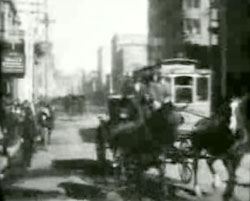 The Edison Manufacturing Company's half-minute kinetoscopic film South Spring Street, Los Angeles, Cal. (1897), shows a busy downtown one-way thoroughfare of horse-drawn carriages, including a huge wagon crammed with passengers & drawn by six white horses.
The Edison Manufacturing Company's half-minute kinetoscopic film South Spring Street, Los Angeles, Cal. (1897), shows a busy downtown one-way thoroughfare of horse-drawn carriages, including a huge wagon crammed with passengers & drawn by six white horses.
We also see pedestrians, an approaching trolley car, & a bicyclist. It's a delightful portrait of an L.A. street near the end of the 19th Century.
This little "actuality" film was advertised in its day as part of the "Southern Pacific Company Series" alluding the the Sunset Route of the Southern Pacific Railroad Company.
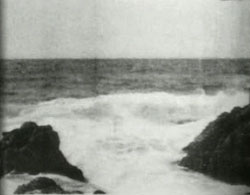 Producer James White's cameraman on the Southern Pacific Railroad project was an Englishman, Frederick Blechynden, who for the same series shot the half-minute Surf at Monterey (1897). Producer James White's cameraman on the Southern Pacific Railroad project was an Englishman, Frederick Blechynden, who for the same series shot the half-minute Surf at Monterey (1897).
This localtion shot was visible to tourists on the train route. We see huge stones raised in shallows of the Pacific & breakers smashing between those rocks onto the beach.
Among the many films generated on White & Blechynden's western journey are those celebrating railroads, spas, hotels, & sundry tourist spots which were partially subsidized by the companies highlighted.
Most of the westward films were travelogue or documentary films, but were in their day called "actualities" for showing "actual" locations or scenes or events or occupations with no imposition of editorial or story content.
The actuality genre would largely vanish as cinema progressed, but remain fascinating documents of an era by right of fudging little or nothing. They're like period snapshots sprung to life.
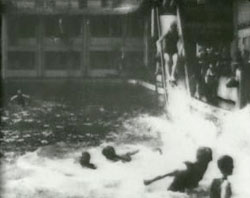 Lurline Baths (1897) is a half-minute film shot in San Francisco. The "bath" is rather more than a bath. It's a large indoor swimming pool with a water-slide.
Lurline Baths (1897) is a half-minute film shot in San Francisco. The "bath" is rather more than a bath. It's a large indoor swimming pool with a water-slide.
A contemporary catalog described the film as showing bathers going down a fifty-foot slide head first, sitting upright, or lying down feet first. But the bathers shown are actually just sliding down in an upright seated position, & the slide ain't that big.
The catalog seems to have confused its own stock of films, as the discription would've been correct for either of two films of the larger & more elaborate Sutro baths, also filmed in San Francisco.
The Lurline Baths & Olympic Club pools were built in 1894, operated by the Olympic Salt Water Company, who fed water into the "saltwater bath" from San Francisco Bay. The pool was located at the corner of Bush & Larkin Street Itclosed in 1936.
The nearby & exceedingly long Lurline Pier between Anza & Balboa Streets (where the the intake for the pool's water had been maintained) was still standing until 1967. Today the location marks the southern edge of what surfers call "Kelly's Cove."
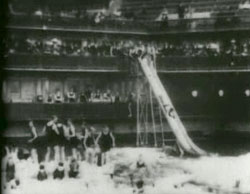 Given the seedy nature ofd the earliest mutoscope & kinetescope film arcades, the choice of "baths" for subjects to be seen in the coin-operated machines would seem to be out of the hope of seeing a bit of skin, but without actually promising any. You pays your nickel & you sees what you see.
Given the seedy nature ofd the earliest mutoscope & kinetescope film arcades, the choice of "baths" for subjects to be seen in the coin-operated machines would seem to be out of the hope of seeing a bit of skin, but without actually promising any. You pays your nickel & you sees what you see.
So another White/Blechynden half-minute or less was Sutro Baths No. 2 (1897). This one does have a large fifty-foot slide, & some of the patrons are going down the slide head-first, seated upright, or lying down feet-first. The pool is surprisingly crowded.
Sutro Baths were the largest privately owned bathhouse in Victorian San Francisco, with one freshwater & six saltwater baths, the city having in this era been famed especially for saltwater baths during a health spa craze.
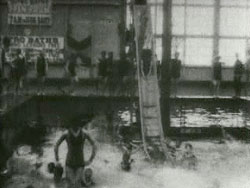 It was built & run as a business by Mayor Adolph Sutro. The area is now part of the Golden Gate National Recreation Area, but the baths themsleves burnt down in 1966. Some ruins can still be seen near Seal Rock below Cliff House. It was built & run as a business by Mayor Adolph Sutro. The area is now part of the Golden Gate National Recreation Area, but the baths themsleves burnt down in 1966. Some ruins can still be seen near Seal Rock below Cliff House.
Although Sutro Baths No. 1 (1897) if it's numbering is any clue was presumedly filmed immediately before No. 2, if they were edited together the first one should come second, as the camera is moved to a closer stationary location. The nearer shot doesn't show the entire slide & we'd have to see No. 2 to realize it's quite large.
Bathers are seen close-up as well, in the rather unrevealing swimsuits of the era. At one point a swimmer, apparently conscious of the mounted camera, stands up to give a little muscle exhibition, then sinks back into the water.
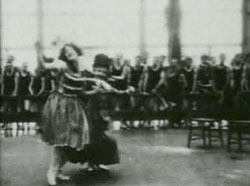 A popular dance at the end of the 1890s was called "the Yellow Kid" incorporating high-steps or kicks like those of a newspaper comic strip character known as the Yellow Kid. The dance wasn't all that different from the much more popular Cakewalk. A popular dance at the end of the 1890s was called "the Yellow Kid" incorporating high-steps or kicks like those of a newspaper comic strip character known as the Yellow Kid. The dance wasn't all that different from the much more popular Cakewalk.
The dance begins with the sisters seemingly spoofing an Irish jig. Then the smaller sister grabs a tophat to play the "man" in a cakewalk prominade.
Filmed on a stage that was part of the Sutro Baths complex, Leander Sisters (1897) gives us a half-minute of the fad dance performed by the titular sisters for a standing audience of male bathers.
It ain't much of a performance & if it was really the highlight of the girls' act, they were stinkeroo. The Leander Sisters can also be seen in the Edision film Cupid & Psyche (1897), shot the same day at the bath.
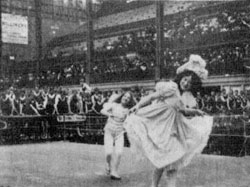 The younger sister is very skimpily clad, with small wings affixed to her back, playing Cupid doing a jig with the elder Leander sister as Psyche. The girls' talent is minimal, & they could just as easily have been skipping around on a playground without the leering men leaning toward them from the front row. The younger sister is very skimpily clad, with small wings affixed to her back, playing Cupid doing a jig with the elder Leander sister as Psyche. The girls' talent is minimal, & they could just as easily have been skipping around on a playground without the leering men leaning toward them from the front row.
Some may find it a little disturbing that a girl probably in her early teens & her even younger little sister would be traipsing around in sundry costumes in front of a huge crowd of men in swim suits. And anyone that felt a little queezy is quite right to do so, as the Olympic Club was for men, not families, & these littler girls are being trundled out in a stag environment.
The seediness of bath house scenes is lost on the primarily male audience unless some dancing girls can be promised, & make no mistake, the first habitues of the kinetoscope parlors were not women & families, but men looking for peepshow activity.
The Edison product frequently pandered to this desire for dancing girls, but made sure the films weren't actually actionable by law. Pushing the age of the dancers to the underaged category did not alter the primary purpose of such films, alas.
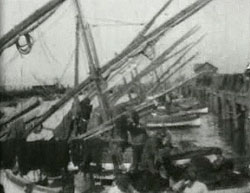 Frederick Blechynden also took us to San Francisco's Fisherman's Wharf for the filming of Fishing Smacks (1897). Frederick Blechynden also took us to San Francisco's Fisherman's Wharf for the filming of Fishing Smacks (1897).
We see many fishing boats anchored at a pier, with fishermen at sundry shore occupations such as untangling nets.
There's not actually much motion in the film, yet it is one of a very appealilng half-minute actuality.
We see quiescent ships barely moving, & the fishermen low in the shot standing in a skiff, & horse nearby almost cut off by the positioning of the camera.
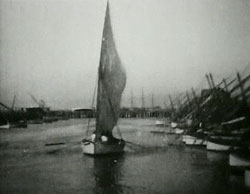 So minimalist it could've been a still photograph with no loss of content content, it neverthless has romantic appeal. So minimalist it could've been a still photograph with no loss of content content, it neverthless has romantic appeal.
Livelier is the half-minute Fisherman's Wharf (1897), showing a little sailboat with sail raised, its crew with long oars rowing the ship into the bay past a moored fleet.
A second little sailboat zips across the background during the last three seconds of the film.
The Wharf films are hardly more than moving post cards, but de rigour for any body of short films documenting San Francisco.
Plus the ships along the main docks were frequently owned by the same railroad companies that were underwriting James & Frederick's filmmaking journey. Indeed, they would themselves eventually be taking off from these docks to continue their filmmaking as far away as in China, though for now, for the coming year they'd keep filming up & down the coast for Durango & San Diego to Seattle.
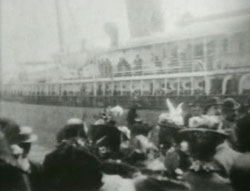 The actuality film S. S. 'Coptic' at Dock (1897) features one of the fastest ships to ply the Pacific at the end of the 19th Century.
The actuality film S. S. 'Coptic' at Dock (1897) features one of the fastest ships to ply the Pacific at the end of the 19th Century.
The S. S. 'Coptic' was on its way to visit Hawaii, Japan, & China. Here it's shown in its San Francisco home port pulling away from the dock as family members of the voyagers stand on the dock waving with their hats.
The immediate sequel is S. S. 'Coptic' in the Harbor (1897) shows the 'Coptic' further out in San Francisco Bay, steam rising from its chimney.
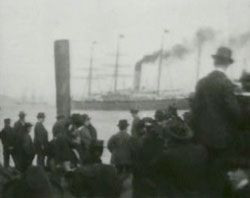 The friends & relatives who had seen the ship off have thinned out, & those remaining are milling about obviously in no hurry to return home, as the tradition of seeing ships off was a social event in & of itself. The friends & relatives who had seen the ship off have thinned out, & those remaining are milling about obviously in no hurry to return home, as the tradition of seeing ships off was a social event in & of itself.
A contemporary catalog claims some Chinese dockworkers can be seen in the shot, but the film isn't so well preserved as to make this evident. Most of the people on the dock are dressed to the nines.
But there is, near the end of the half-minute, a line of three short men not as well dressed, quickly leaving the area. Perhaps they're Chinese, perhaps not, but they don't appear to be laborers either, & may have been relatives seeing off steerage-class voyagers returning to China, as the 'Coptic' was famous as an immigrant ship.
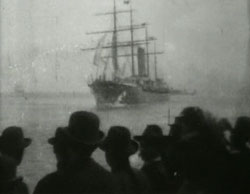 Third in this trilogy is S. S. 'Coptic' Sailing Away (1897). This episode shows the elegantly beautiful ship leaving the bay & heading out into the Paciafic. Third in this trilogy is S. S. 'Coptic' Sailing Away (1897). This episode shows the elegantly beautiful ship leaving the bay & heading out into the Paciafic.
Though the ship has a steam chimney, it also has the rigging of a tallship, & in the distance really looks more like a sailing tallslhip, not a steamer.
Compared to the majority of Blechynden's films, this last one's an usually grand composition, as he has filmed over the heads of men standing on the dock in sharp shilhouette.
By their dressy bowlers these men obviously came to see friends off, & are not dockworkers. This is all the more obvious when one spots two women moving into the camera's view, wearing fancy feathered hats, as it was expected that one would don their Sunday best to head down to the docks & wave goodbye to voyagers.
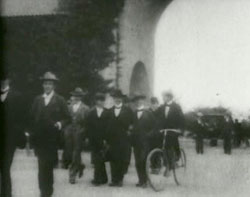 Another San Francisco scene captures Stanford University, California (1897) of students & instructors leaving the campus in Palo Alto mostly afoot, some on bicycles.
Another San Francisco scene captures Stanford University, California (1897) of students & instructors leaving the campus in Palo Alto mostly afoot, some on bicycles.
All the young men are very sharply dressed, & there is narry a woman in sight. It's a half-minute with stationary camera like nearly everything filmed by Blechynden.
The arch that frames the film & through which everyone is passing collapsed in the Great San Francisco Earthquake of 1906.
Procession of Floats (1898) was filmed during the return journey to San Francisco, after White & Blechynden had journeyd to Seattle (see some of their Seattle films reviewed here, a page that also has a few more San Francisco films covered).
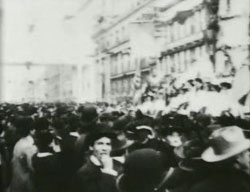 This parade occurred on the first day of the week-long Golden Jubiilee celebrations, marking fifty years since the California Gold Rush. This parade occurred on the first day of the week-long Golden Jubiilee celebrations, marking fifty years since the California Gold Rush.
With stationary cameras in public settings, a cameraman was often at the mercy of a crowd that could easily "spoil" a half-minute sequence by getting in the way of a shot. This film has two amusing incidents imposed by the public, but which add to rather than detract from the film's uniqueness.
As a great white firemen's float approaches the camera, Blechynden is shooting over the heads of the dense masses of streetside observers. The float is drawn by white horses & is loaded down with more girls than firemen, the majority of firemen marching along behind the float.
One young man in the crowd is biting his nails as he turns his back to the parade, gazing directly into the camera which he clearly finds more fascinating than the parade float.
We next see a float in the form of a covered wagon drawn by mules, symbols of the gold rush. Again the public pokes into the shot when the top of a boy's head appears right in front of the camera, at first as a black circle which is the back of the lad's hat. Blechynden apparently yells at him to get out of the way, as he whirls about in a startled manner then leaps out of the camera's eye.
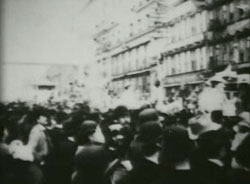 Without these two moments from the crowd, there really wouldn't be much of interest in this half-minute fragment of a parade, but two intrusions in a single short shot makes it rather a marvel of the "actuality" genre. Without these two moments from the crowd, there really wouldn't be much of interest in this half-minute fragment of a parade, but two intrusions in a single short shot makes it rather a marvel of the "actuality" genre.
Another fragment of the San Francisco Golden Jubilee parade is featured in the equally short Native Daughters (1898), shot from the same angle over the heads of the dense crowd of onlookers.
Riding past in the parade is a group of city matrons on horseback, dressed in white with Alpine hats that almost look like cowgirl hats. They're followed by a float drawn by white horses. Poorly preserved, the detail of this film is just too faded to have left much of an impact. Plus it lacks the audience intrusions that lent appeal to Procession of Floats.
copyright © by Paghat the Ratgirl
|
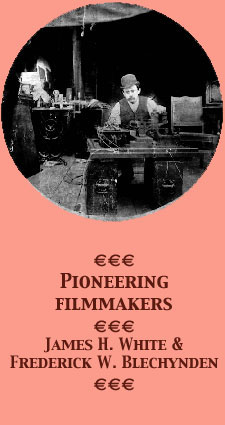

 Producer James White's cameraman on the Southern Pacific Railroad project was an Englishman, Frederick Blechynden, who for the same series shot the half-minute Surf at Monterey (1897).
Producer James White's cameraman on the Southern Pacific Railroad project was an Englishman, Frederick Blechynden, who for the same series shot the half-minute Surf at Monterey (1897).

 It was built & run as a business by Mayor Adolph Sutro. The area is now part of the Golden Gate National Recreation Area, but the baths themsleves burnt down in 1966. Some ruins can still be seen near Seal Rock below Cliff House.
It was built & run as a business by Mayor Adolph Sutro. The area is now part of the Golden Gate National Recreation Area, but the baths themsleves burnt down in 1966. Some ruins can still be seen near Seal Rock below Cliff House.
 The younger sister is very skimpily clad, with small wings affixed to her back, playing Cupid doing a jig with the elder Leander sister as Psyche. The girls' talent is minimal, & they could just as easily have been skipping around on a playground without the leering men leaning toward them from the front row.
The younger sister is very skimpily clad, with small wings affixed to her back, playing Cupid doing a jig with the elder Leander sister as Psyche. The girls' talent is minimal, & they could just as easily have been skipping around on a playground without the leering men leaning toward them from the front row.
 So minimalist it could've been a still photograph with no loss of content content, it neverthless has romantic appeal.
So minimalist it could've been a still photograph with no loss of content content, it neverthless has romantic appeal.
 The friends & relatives who had seen the ship off have thinned out, & those remaining are milling about obviously in no hurry to return home, as the tradition of seeing ships off was a social event in & of itself.
The friends & relatives who had seen the ship off have thinned out, & those remaining are milling about obviously in no hurry to return home, as the tradition of seeing ships off was a social event in & of itself. Third in this trilogy is S. S. 'Coptic' Sailing Away (1897). This episode shows the elegantly beautiful ship leaving the bay & heading out into the Paciafic.
Third in this trilogy is S. S. 'Coptic' Sailing Away (1897). This episode shows the elegantly beautiful ship leaving the bay & heading out into the Paciafic.
 This parade occurred on the first day of the week-long Golden Jubiilee celebrations, marking fifty years since the California Gold Rush.
This parade occurred on the first day of the week-long Golden Jubiilee celebrations, marking fifty years since the California Gold Rush. Without these two moments from the crowd, there really wouldn't be much of interest in this half-minute fragment of a parade, but two intrusions in a single short shot makes it rather a marvel of the "actuality" genre.
Without these two moments from the crowd, there really wouldn't be much of interest in this half-minute fragment of a parade, but two intrusions in a single short shot makes it rather a marvel of the "actuality" genre.